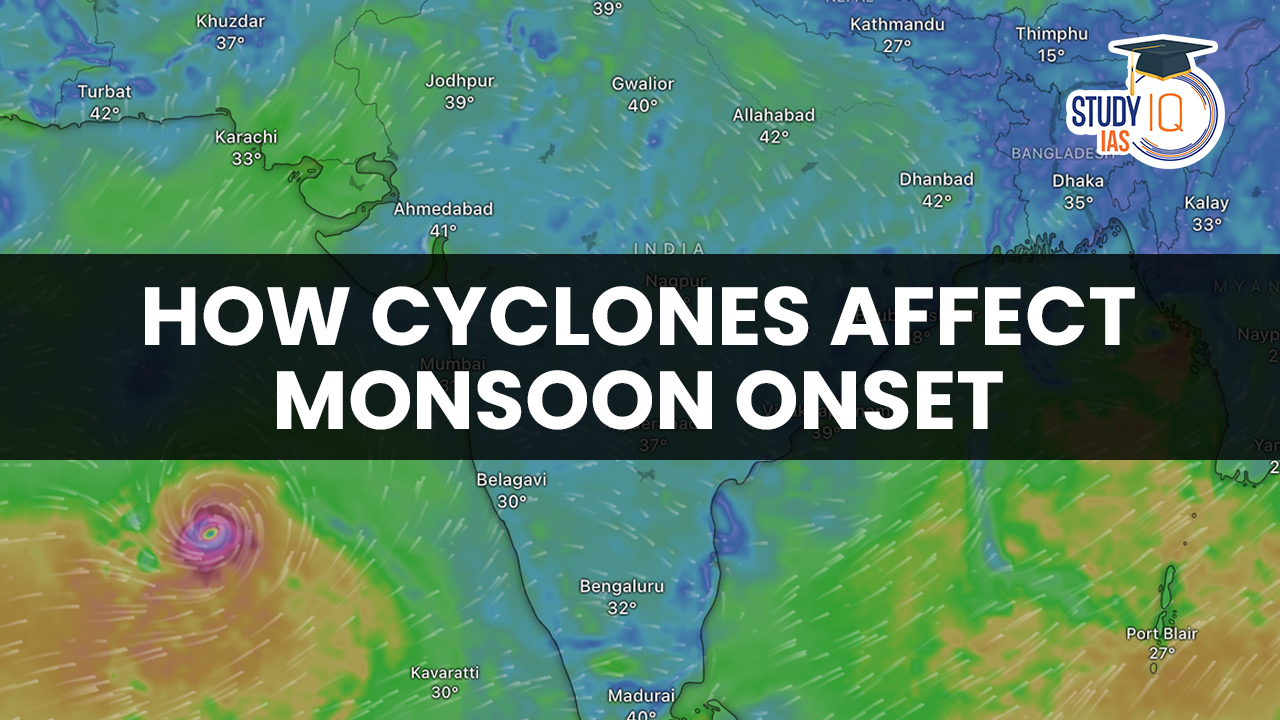Table of Contents
Context: The impact of global warming on the monsoons can be seen in the onset, withdrawal, its seasonal total rainfall, and its extremes.
How Cyclones Affect Monsoon Onset Background
- Global warming has started affecting the cyclones over the Indian Ocean and the typhoons over the northwestern Pacific Ocean.
- Cyclone formations in the pre-monsoon cyclone season are visible, closer to the monsoon onset, due to the influence of a warmer Arctic Ocean on winds over the Arabian Sea.
Also Read: Cyclone Biparjoy
What is Monsoon?
- Monsoons refer to a system of winds in the tropical regions under which the direction of winds is reversed completely between the summer and the winter seasons.
- Under this system, the winds blow from land to sea in winter and from sea to land in summer.
- Process: The primary cause of monsoons is the difference between annual temperature trends over land and sea.
- The position of the Sun with reference to the Earth oscillates from the Tropic of Cancer to the Tropic of Capricorn.
- Thus, the low pressure region created by solar heating also changes latitude.
- The northeast and southeast trade winds converge in this low pressure zone, which is also known as the Intertropical Convergence Zone or ITCZ.
- This low pressure region sees continuous rise of moist wind from the sea surface to the upper layers of the atmosphere, where the cooling means the air can no longer hold so much moisture resulting in precipitation.
- Indian Monsoon: The Indian subcontinent covering countries like India, Nepal, Pakistan, Myanmar, Bangladesh and Sri Lanka experiences the summer monsoon.
- During the months of May to September, the wind carries the warm moist air from the southwest Indian Ocean to the subcontinent with heavy torrential rainfall, it is known as Southwest Monsoon.

What is Onset of the Monsoon?
- The onset of the monsoon over Kerala signals the beginning of the four-month (June-September) southwest monsoon season, during which India gets more than 70% of its annual rainfall.
- Contrary to what is sometimes assumed, the onset does not mean the first rain of the season. That can start happening in certain places even before the onset is declared.
- India Meteorological Department (IMD) announces the onset of the monsoon only after certain precisely defined and measurable parameters:
- Rainfall: The onset is declared if at least 60% of 14 designated meteorological stations in Kerala and Lakshadweep record at least 2.5 mm of rain for two consecutive days at any time after May 10.
- Wind Field: The depth of westerlies should be in the area that is bound by the equator to 10ºN latitude, and from longitude 55ºE to 80ºE.
- Heat: The measure of the energy emitted to space by the Earth’s surface, oceans, and atmosphere should be in the area between the 5ºN and 10ºN latitudes, and 70ºE and 75ºE longitudes.
- Factors Influencing the Onset of Southwest Monsoon:
- Intense low-pressure formation over the Tibetan Plateau
- The permanent high-pressure cell in the South of the Indian Ocean
- Subtropical jet stream (Jet streams are bands of strong wind that generally blow from west to east all across the globe)
- African Easterly jet (Tropical easterly jet)
- ITCZ

How Does Global Warming Impact Indian Monsoon?
- Intensity of rains: Rapid increase in floods and droughts provides direct evidence of how global warming has been impacting the Indian monsoon.
- While summer monsoon rainfall each year is unique, there was a large regional and temporal variability in rainfall last year.
- Fluctuations: There is evidence that global warming increase the fluctuations in the monsoon, resulting in both long dry periods and short spells of heavy rains.
- Interconnectivity between oceans: The monsoon is also affected by the three tropical oceans: Indian, Atlantic, and Pacific: the ‘atmospheric bridge’ from the Arctic; and the oceanic tunnel as well as the atmospheric bridge from the Southern Ocean (Antarctic Ocean).
- A ‘bridge’ refers to two faraway regions interacting in the atmosphere while a ‘tunnel’ refers to two remote oceanic regions connecting within the ocean.
What are Cyclones?
- Cyclones are rapid inward air circulation around a low-pressure area. The air circulates in an anticlockwise direction in the Northern hemisphere and clockwise in the Southern hemisphere.
- Impact of Cyclone’s Position on Monsoon Onset: Cyclone are forming in the pre-monsoon season, closer to the monsoon onset, arguably due to the influence of a warmer Arctic Ocean on the winds over the Arabian Sea.
- Some cyclones in the North Indian Ocean have had both positive and negative impacts on the onset of the monsoon.
- Since the circulation of winds around the cyclones is in the anticlockwise direction, the location of the cyclone is critical as far as the cyclone’s impact on the transition of the monsoon trough (low-pressure region) is concerned.
- If a cyclone lies further north in the Bay of Bengal, the back-winds blowing from the southwest to the northeast can pull the monsoon trough forward, and assist in the monsoon’s onset.
- One severe consequence of the anticyclones since March is that both the Arabian Sea and the Bay of Bengal have warmed by more than 1º C in the pre-monsoon season.
Recent Cyclones/Typhoons
- Cyclone Biparjoy: It is not interacting much with the monsoon trough currently. However, its late birth as well as the late onset of the monsoon are both closely related to typhoons in the northwestern Pacific Ocean.
- Guchol: Tropical storm Guchol is now active just to the east of the Philippines and is likely to continue northwest before turning to the northeast. These powerful typhoons are extremely dry and demand moisture from far and wide.
- Typhoon Mawar: It is qualified as a ‘super typhoon’ and is thus far the strongest typhoon to have taken shape in May. It is also the strongest cyclone of 2023 so far.

Impact of Southwesterly Winds on Indian Monsoon
- Arabian Sea: Southwesterly winds over the Arabian Sea are welcome news because they bring large quantities of moisture onto the Indian subcontinent.
- Bay of Bengal: On the other hand, southwesterly winds over the Bay of Bengal are bad news for the monsoon.
- The monsoon winds over the southern Bay of Bengal sweep in from the southwest and west, but they turn around and head northwest towards India from the southeast.
How Cyclone’s Effect on Monsoon impacts Monsoon Prediction?
- Monsoon Trough: It was once considered a reliable system, is now subject to the uncertainties of climate change.
- Challenge to Prediction: The interplay between global warming, cyclogenesis and typhoon activity in the Pacific and North Indian Oceans has dented accurate predicting the monsoon onset and its evolution.
- Late Monsoon: Cyclone can delay monsoon onset. However, a delay in the onset over Kerala can potentially delay the arrival of the monsoon in other parts of the country, especially in the southern states.


 Story of Meera Bai and Her Devotion For ...
Story of Meera Bai and Her Devotion For ...
 Desert Climate, Distribution, Climatic C...
Desert Climate, Distribution, Climatic C...
 Deserts of India Map, Features of Thar D...
Deserts of India Map, Features of Thar D...





















